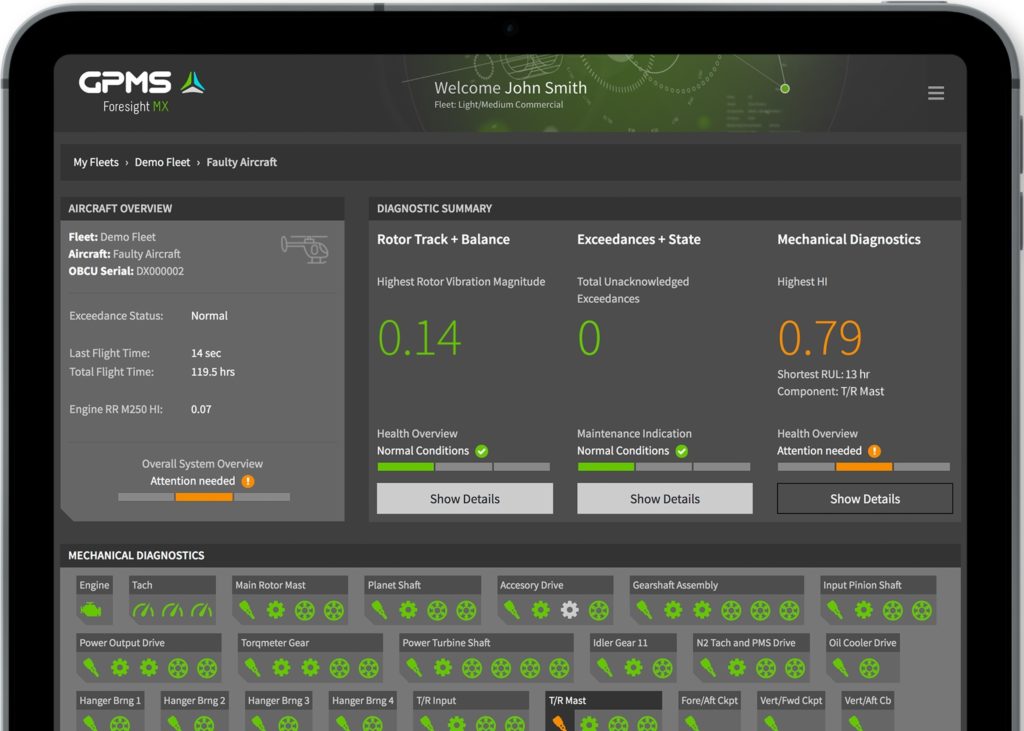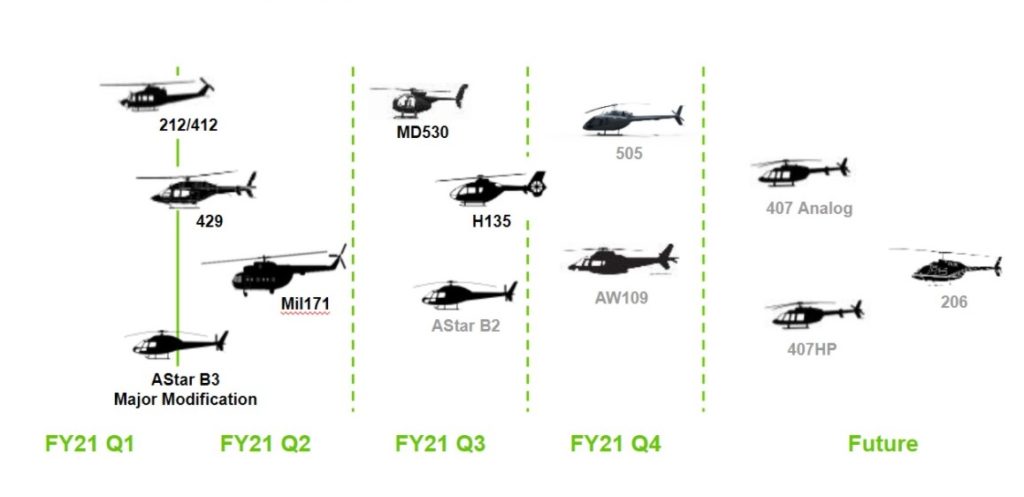Green Power Monitoring Systems (GPMS) raised a Series A financing round of undisclosed amount led by DiamondStream Partners to continue expanding the presence of its predictive maintenance and health and usage monitoring system (HUMS), Foresight MX, in the helicopter market and other verticals.

Employing a mix of hardware and software innovation, Foresight MX reviews information provided by vibration analysis as a kind of “CT scan for helicopters” to assist maintainers. With usage and flight data uploaded to the cloud for remote access, maintenance teams can often identify likely mechanical failures before they occur and review the effect of exceedances before visiting the manufacturer or an approved maintenance facility.
The company’s goal, for the moment, is to get Foresight operational on as much of the Part 27 rotorcraft market as possible. GPMS has earned supplemental type certificates (STCs) for the Bell 407 GX/GXP/GXi and Airbus H125 with many more expected in 2021. Andrew Swayze, head of marketing and strategy, told Vertical an estimated 80-90 percent of the aftermarket fleet remains unconnected — an opportunity for GPMS and for operators to improve utilization, reduce unscheduled maintenance events and improve resale value of assets.
“It’s really a software solution, so we emphasize the user interface. The maintainer can view aircraft health via a green, orange, red type of system and get text alerts if there’s an issue,” Swayze said. “We’re logging data off the avionics, so we’re capturing flight data monitoring and exceedances. And with sensors that are far more sensitive than human senses we deliver the mechanical diagnostics component that lets the maintainer drill into components that are trending. Finally, our remaining useful life (RUL) estimates deliver that predictive piece that allows for logistics planning and fleet optimization.”
Duke Energy, the pilot customer for GPMS’ 9.75-pound (4.4-kilogram) system on the 407, decided to partner with the company for the STC process and outfit its entire fleet, including the company’s Bell 429s.

Based on data from Conklin & deDecker and the results of equipping Duke’s 407 fleet, GPMS and the consultancy calculated the annual return-on-investment for Foresight MX to be $45,920. That includes $23,850 in lower costs through optimized troubleshooting and maintenance activity, $9,750 in increased revenue through asset availability, and $12,500 in preserved asset value through digital record keeping.
“An element captured in the maintenance savings is Duke probably spent four hours twice a year doing rotor balancing, which they were able to shorten to about 20 minutes using Foresight MX,” Swayze said. “That’s like $9,000 in savings a year in RTB alone, per year, if you look at cost attribution, especially if you’re using an external maintenance organization.”
According to Swayze, one customer received a new aircraft equipped with Foresight and quickly began receiving alerts that numerous engine-related components were trending. Those trends eventually became significant and the aircraft was deemed unsafe to fly. When the customer approached the manufacturer to acquire a replacement, data showing the engine was faulty from the get-go proved a critical piece of the negotiation.
To fit the budgets of operators, Swayze said the company has restructured its pricing, shifting toward a HUMS-as-a-service model with less up-front costs and an annual subscription that pays for itself more than twice over. For a light helicopter like the H125, the up-front installation cost is $35,000 with an annual recurring cost of $15,000 that includes a hardware warranty.
Enabling the eVTOL model
GPMS is also engaged in the nascent electric vertical takeoff and landing (eVTOL) market, working with Vermont-based Beta Technologies and numerous other unnamed startups to explore integration of its HUMS system.
The eVTOL business model — centered around air taxi services — relies on achieving extraordinarily high aircraft utilization rates, leveraging the lower expected operating costs of electric aircraft, to offer vertical flight to new markets at lower costs.
Archer and Joby Aviation, two competitors that recently closed deals to go public and raise more than $1 billion each in mergers with blank-check acquisition firms, are targeting 1,825 and 2,500 annual flight hours per aircraft, respectively.
Predictive maintenance and HUMS will clearly play a role in achieving those utilization rates as well as lower operating costs, though numerous eVTOL developers contacted for comment declined to share many specifics.
“Lilium is looking into predictive maintenance system to ensure a high aircraft availability,” a company spokesperson told Vertical. “The aircraft system shall include a high degree of self-testing to trigger maintenance activities prior to operational disruption.”
Part of that is achieved through HUMS and predictive maintenance to reduce unscheduled maintenance, but GPMS sees an opportunity — eventually, working in tandem with regulators — for connected monitoring systems like Foresight MX to eventually reduce scheduled maintenance needs.
“We do see a possibility to use monitoring technologies like this to potentially extend out the time between overhauls and as a result, lower the operational costs of running these machines through kind of a virtual inspection regime,” said Swayze. “But it’s very early days around what the Federal Aviation Administration is going to require in this regard and also what the potential implications might be for the software certification levels.”
Today, Foresight MX is certified as a Design Assurance Level (DAL) E software system under DO-178B because it provides maintenance support data that isn’t necessarily critical to flight. If, in the future, maintenance needs were being determined exclusively by a system such as Foresight MX, the FAA would likely place more stringent requirements on it.
“If on one end of the spectrum is standard one-size-fits-all scheduled maintenance and on the other is pure on-condition maintenance, we see the regulatory framework gradually shifting to incorporate more on-condition data,” Swayze added. “And if you’re going to move in that direction, you fundamentally have to have a system like Foresight MX on board.”









